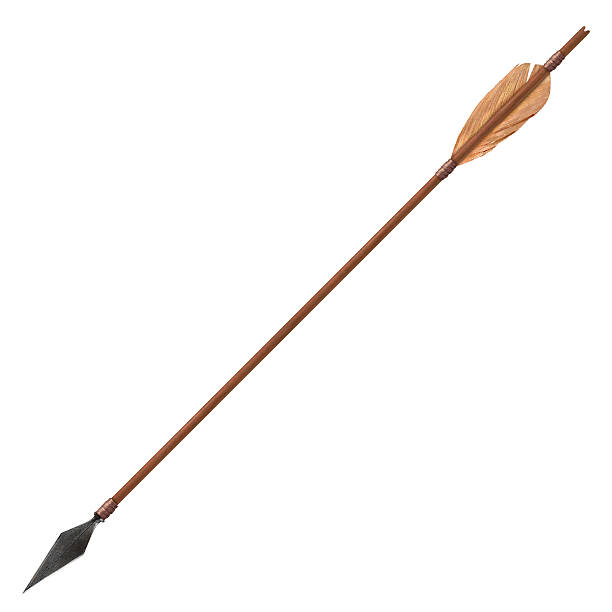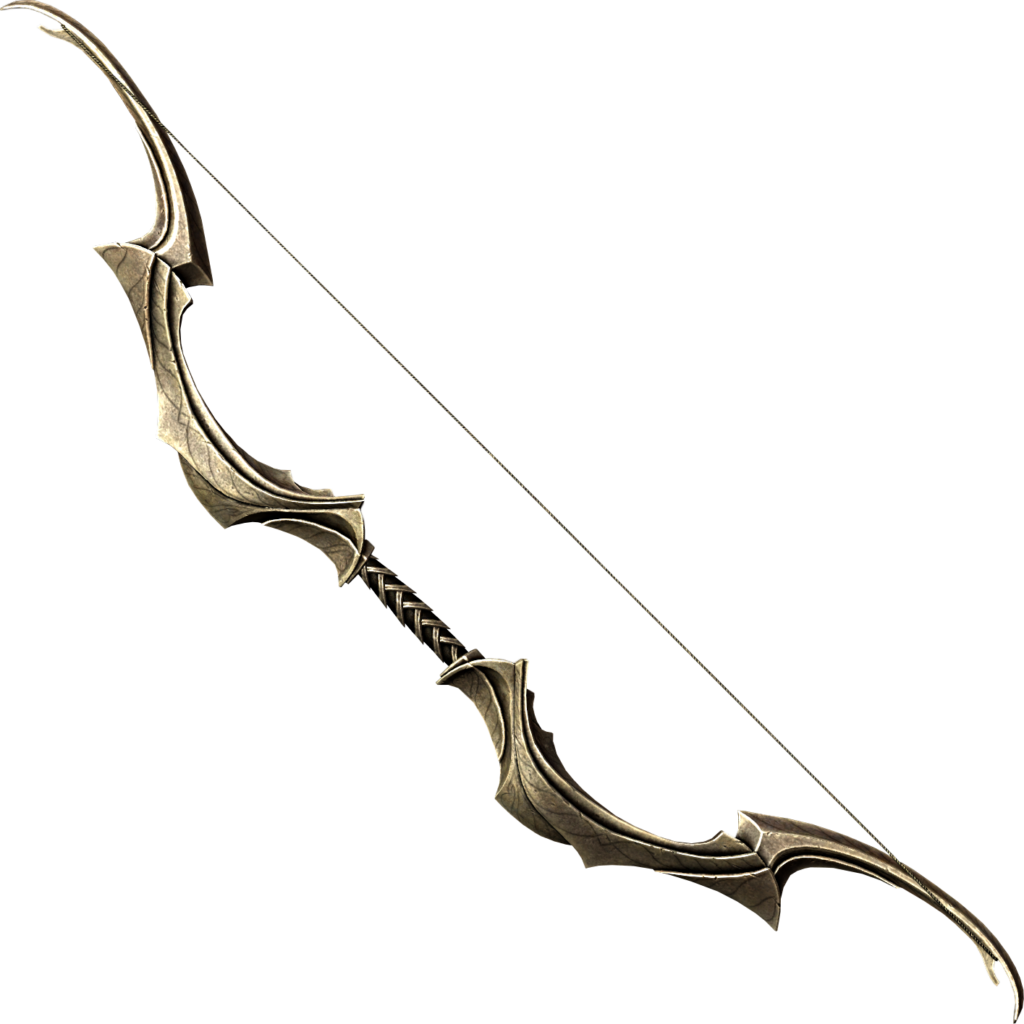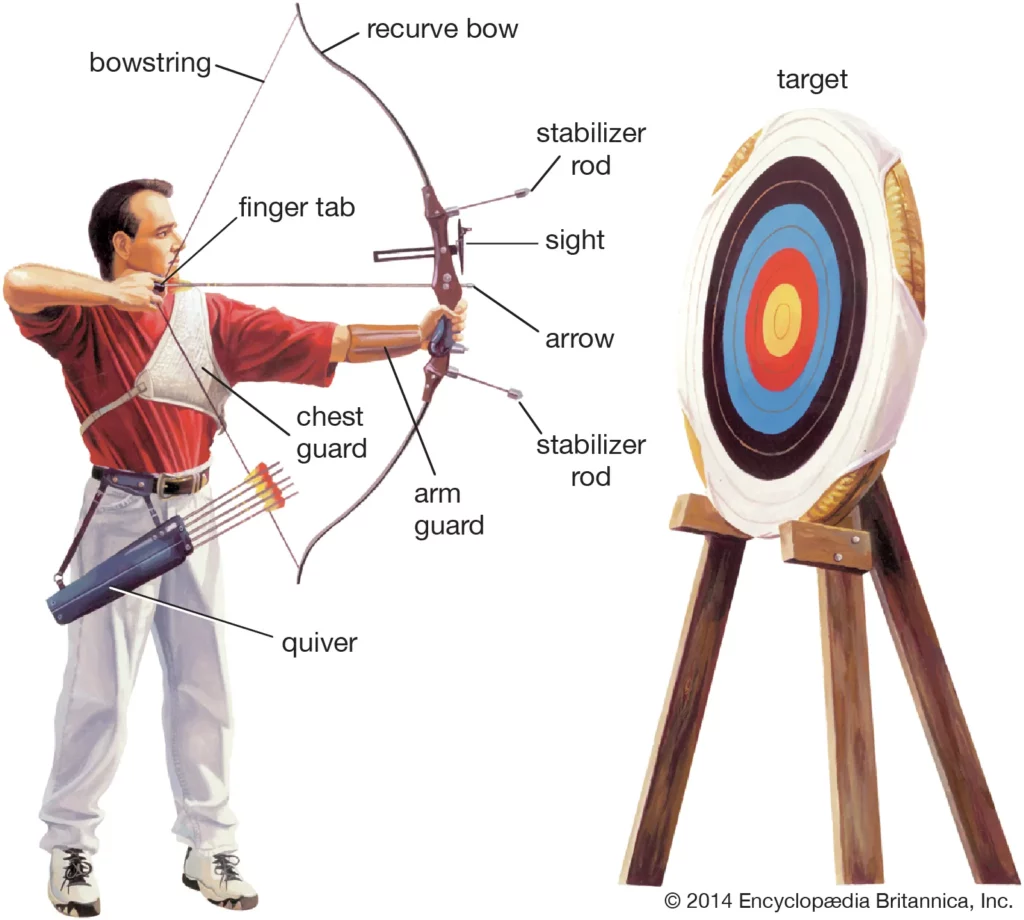
Bow

The bow and arrow is a projectile weapon and tool that dates back to the Paleolithic period. Bow and arrow history is quite broad; numerous cultures independently developed a bow and arrow, with the weapon playing an important role in the cultures and communities that held it. With the bow and arrow being an integral component of cultures ranging from the Amazon to China, many distinct types of bows serve a specialized purpose. The term “bow and arrow” refers to the weapon’s two primary components: the “bowed” or bent handheld half of the weapon and the long, often pointed projectile of the arrow.
What exactly are a bow and an arrow?
A bow and arrow are weapons made up of a stave made of wood or other elastic material that is bent and tensioned by a string. The arrow, a slender wooden shaft with a feathered tail, is attached to the string via a notch at the end of the shaft and dragged back until enough tension is produced in the bow to launch the arrow when released. Arrowheads have been fashioned from shaped flint, stone, metal, and other tough materials.
History
The bow and arrow have prehistoric beginnings; bone arrow tips dating back 61,000 years have been discovered in South Africa’s Sibudu Cave. From prehistoric times to the Middle Ages, the bow was a prominent combat weapon.
Ages throughout the Mediterranean and Europe, and even longer in China, Japan, and the Eurasian steppes. In the last scene of Homer’s Odyssey, Odysseus’ skill with the bow proves pivotal in his battle with Penelope’s suitors. According to the Bible, Ahab was killed by an enemy arrow that “hit the king of Israel in the joints of harness.”
The armoured soldiers of Greece and Rome typically despised the bow, but were frequently ambushed by skilled enemy archers, particularly those mounted on horseback.
The Huns, Seljuq Turks, Mongols, and other Eurasian steppe peoples were exceptionally skilled mounted archers, carrying powerful composite recurved bows crafted of thin wood laths stiffened at the back with strips of horn and strengthened at the front with glued-on layers of bovine sinew. Until the invention of the revolving pistol, these were the most formidable missile weapons of mounted combat.
The invention of the crossbow, which was known in ancient times but improved in the Middle Ages, and the English longbow, which was introduced to European battlefields in the 14th century, made the arrow a powerful combat missile in Europe.
The famed cloth-yard shaft was nearly half the length of the famous longbow, which appears to have originated in Wales. The bow was held outstretched with one arm, and the arrow was pulled back to the bowman’s ear. An English archer could fire six focused shots per minute, with an effective range of around 200 yards, while an arrow may travel twice that far in the right hands.
The crossbow, on the other hand, did not necessitate the same physique or training. The crossbow was made up of a short bow set horizontally on a stock or tiller, as well as a sear and trigger to keep the string drawn and ready to be discharged on demand.
Crossbows were less accurate than longbows or composite bows in competent hands, but they were extremely effective at short and medium range.
The bow’s relevance in combat has been overshadowed by its value as a hunting weapon in many cultures. The normal bow or the crossbow was employed in both hunting and warfare by North American Indians, Eskimo, many African peoples, and others. Some ancient Japanese hardwood bows are 8 foot (2.44 meters) long; the Japanese also fashioned smaller horn or whalebone bows. Japanese bows and quivers (used to hold arrows) were frequently ornately adorned and signed by the artisan. The Andaman Islanders, who live between the Andaman Sea and the Bay of Bengal, made unusually wide and broad bows.
Because ranges in the African forest were usually limited, African bow makers tended to construct tiny bows. The Eskimo utilized composite bows of wood and bone supported by sinew, similar to most Asian bows. Bows were manufactured of wood or wood supported with sinew by the American Indians. Bows have also been manufactured from a variety of materials, including wood and horn or wood and metal. Composite bows of today are made of laminated wood, plastic, or fiberglass. The contemporary compound bow’s cable and pulley system improves accuracy and power. Many sport hunters prefer bows over rifles, while others hunt with both.
The string, too, can be made of a variety of materials, with durability being a need. Bowstrings have been made from a wide variety of materials. The string on an English longbow in the Middle Ages was mainly linen or hemp, whereas Turkish and Arab bows were strung with silk and mohair. In many parts of the world, rattan, bamboo, vegetable fiber, and animal sinew or hide have been used.
Arrows have shown considerably more variance. The shaft is usually a single piece, but two different materials, such as wood and metal, are frequently mixed; the arrowhead, which can be made of metal, stone, bone, or shell, can be attached by socketing, cementing, or both. Fletches of feathers or substitutes (leaves, leather, or fur) are almost generally employed to stabilize the arrow in flight; but, arrows with hefty foreshafts may be unfletched.
Types of Bhttps://en.wikipedia.org/wiki/Bow_and_arrowow and Arrow
Bows and arrows come in a variety of shapes and sizes, but they all work on the same basic premise as a missile weapon. The recurve bow, so named because the limbs “recurve” at the ends so that the points of each limb face the front of the bow, is one style of bow. The compound bow is a form of bow that uses hoists and cables to propel the arrow further. There’s also the longbow, which is a very old and classic bow. The long bow, as the name implies, is long; this allows for a more considerable pullback and a greater distance attained by the arrow. While arrows are not as diversified as bows, there are various varieties.
Some may differ in size and weight, while others may differ in substance. A wooden arrow with a bone tip and bird feather fletching (the stabilizing counterweight of an arrow opposite the tip) could be symbolic of a more traditional or old bow. A more modern bow can be composed of metal and fletched with plastic or fiberglass. Archers, both historical and modern, were meticulous about their arrows and bows. Other varieties of bows are discussed in the sections that follow.
These bows are really simple but yet extremely ancient. The self bow, formed from a single bent piece of wood, is representative of early historical bow shapes.
A sequence of self-bows discovered in northern Europe date back to around 10,000 BCE. Other varieties of this bow, however, extend back tens of thousands of years.
Around 2500 BCE, horseback-riding archers in Central Asia devised the composite bow. They made the first composite bows by combining wood, sinew, and animal horns to make a more flexible material than plain wood.
Crossbow
Around 450 BCE, the crossbow was conceived in China. This type of bow allows the archer to draw the arrow back and prepare to shoot, but it will not fire until the archer pulls the latch.
When Did the Bow and Arrow First Appear?
Outside of Africa, the earliest remains of a bow and arrow have been discovered in Europe, with fragments dating back over 17,000 years and relatively intact remains dating back roughly 8,000 years. By 4,000 BCE, the Egyptians had constructed reed bows to hunt lions along the Nile River, and there is sufficient evidence of bow and arrow use. To improve the accuracy of archery, mathematicians such as Eratosthenes calculated arrow trajectories based on wind speed. Even later, in the 13th and 15th centuries, the Mongols deployed military archers to defeat Constantinople and the Byzantine Empire. Archery is still a vital and expressive sport and art form all across the world.
The various varieties of archery arrows
Any archer’s choice of bow and archery equipment is critical. Archery arrows are one of the most significant archery gears. In the lingo, they are also known as tubes or shafts. They should not be chosen haphazardly. So, what are the different sorts of archery arrows, and which ones should you buy to round out your arsenal?
What is the composition of an archery arrow?
To begin with, an archery arrow is made up of four indivisible parts. Each of these can have an impact on the arrow’s flight. What exactly are these components?
The tube: this is the arrow’s body. It might be more or less rigid depending on the material used to make it.
The notch: is the plastic piece at the tip of the arrow. It is used to notch the arrow to the bowstring before shooting, as the name implies.
The hint is that this is the end that will make contact with the objective. It might have a pointy, rounded, or suction cup tip.
4 Types of Arrowhttps://tecplusmore.com/bows-and-arrows-history-uses-and-types/s for Archery by Material
The wooden arrow
There are four primary varieties of arrows based on their material: wooden arrows, aluminum arrows, carbon arrows, and aluminum carbon arrows. There are, however, fiberglass arrows.
These wooden arrows are primarily intended for use with traditional bows and longbows. They are typically built of cedar, pine, spruce, or sitka spruce. As a result, the range of stiffness is quite broad. These barrels can be customized and are frequently more aesthetically pleasing than others. They are, however, more delicate.
The aluminum arrow is more precise than the wooden arrow. It is also adaptable, as it may be used on a variety of bows, including traditional and compound bows. The aluminum shaft is widely employed in indoor (or club) shooting and, on occasion, in introductory shooting.
This is the most popular arrow used by archers today. This material is quite adaptable and may be used in a variety of disciplines, including bow hunting, recreational shooting, sport shooting, target shooting, competition, and so on. Small diameter carbon arrows are great for nature or 3D shooting. For beginners’ shooting and learning, cheaper shafts, such as those made of aluminum, might be used.
The aluminum carbon arrow
They are high-quality arrows that are extremely popular among skilled archers and experts. They are useful for long distance shooting and low power bows when they have a small diameter.
Which material is appropriate for which shooting discipline?
Which Material for which Shooting Discipline?
Depending on the shooting discipline and practice, experts recommend different types of arrows:
For longbows: wooden and carbon arrows.
For recurve bows: wooden arrows, carbon arrows (especially for outdoor shooting), aluminium arrows (for indoor shooting) and carbon aluminium arrows.
For recurve bows: wood and aluminium arrows.
For compound bows: carbon (for target shooting), aluminium and carbon aluminium arrows.
Which Arrow Size Should You Use?
In addition to the material, the appropriate arrow size is critical for the optimum shooting performance. The draw length, power, and spine of the bow of the archer are all important elements to consider.
Draw length
The distance between a shooter’s hand and the bow handle when in a shooting position is referred to as the draw length. It differs depending on the shooter’s gender, age, and height. It is commonly measured in inches. Knowing your draw length makes it easy to locate the appropriate arrows.
Power
Every bow has a power rating, and sometimes a power range, which is usually indicated on the limbs. A scale, which is available in archery shops and clubs, can be used to measure power. It is also measured in inches.
The spine
The stiffness or spine of an arrow is intimately related to its power. It is also an important issue to consider. If you’re shooting with a low-power bow, go with a soft arrow with a spine of 1200. A substantially stiffer arrow with a spine of 400 is required for a high-powered bow.
How would this knowledge benefit you? In reality, each manufacturer provides selection tables, instructions, or software based on the characteristics of their products.
The Easton table is arguably the most well-known. Based on these measurements, they recommend the best arrow size/dimensions for you.
Archery is a tool in the human arsenal that dates back 10,000 years. It now takes on several different forms.
Bow Components
Archery bows are made up of three major components: limbs, risers, and bowstrings.
Before we go into each type of bow, it’s crucial to understand what you’re looking at. These sections may seem and perform differently in different styles, but they all fulfill the same objective.
Limbs
The limbs flex and produce the force that will move into and propel your arrow ahead. They are affixed to the riser and keep the bowstring in place at both string nocks.
Riser
The riser is the central section of the bow that houses the grip, arrow rest, and sight window. This is frequently made of wood and, in some cases, composite materials. The riser you require depends on whether you are left- or right-handed. Before purchasing, make sure you know which arm you will be drawing with!
Bowstring

Recurve
The recurve bow is one of the oldest bows known to man, designed for both beginners and experts. Bows were first used around 800 B.C. Because of its long history, the recurve bow is the most tried-and-true bow type on our list.
Recurve bows are frequently constructed from multiple layers of fiberglass, carbon, or wood, with a wood or composite riser. As a result, dry fire (firing without an arrow), as with all bows, can be exceedingly deadly. Dry firing can cause damage to any bow, and that damage can be harmful to you. It should be avoided at all costs.
On the plus side, a recurve bow is ideal for learning and progressing. Recurves are now the only bows permitted in the Olympic Games, so if sport shooting is your objective, you’ll need a recurve.
If you’re new to archery, the Samick Sage Takedown is a good place to start. It is highly recommended for beginners and provides a wide range of draw weight (how difficult it is to pull back the bowstring) and size possibilities.
Longbow
The longbow is a medieval weapon that excels in its simplicity. It’s essentially a long wooden pole with a string attached to both ends.
The longbow is the most difficult of these four varieties to wield and shoot accurately because to a lack of technical developments. The draw weight increases as the bow lengthens. In combat, these bows needed exceptionally powerful archers and produced lethal power.
Now that we’ve moved past that era, the longbow is mostly utilized for target shooting. Longbows and recurves are still used by competent hunters in the field. They can also defeat any type of game with them.
The difficulty in pulling back the longbow without aids such as sights makes the longbow a weapon for masters. However, if you want to start a pastime as a bowyer, this is the easiest bow to manufacture.
Compound
The compound bow is one of archery’s most significant technological advances. The compound bow did not appear until the 1960s.
The archer can handle heavy draw weights with little effort by using a system of pulleys, cams, and cables on the bow. This means that once you’ve overcome the strain of the initial draw, you’ll be able to hold your bow stable and take more time to aim accurately.
Using sights and releases, the action of a compound bow may be dialed in to an extraordinary amount for accuracy at long distances. With rotating cams and let-off, power is much easier to achieve.
It’s no surprise that while hunting for wild game, most hunters grab for a compound bow.
The crossbow has taken traditional archery and flipped it on its head, adding a trigger release mechanism.
Crossbows have much shorter limbs and almost no riser since the grip is located elsewhere on the bow. Because the shorter bow demands a considerably higher draw weight, the bowstring is pulled back using a crank mechanism. It’s simple to aim and pull the trigger once the arrow is knocked.
Crossbow hunting is only authorized in most states during rifle or shotgun seasons, so check your state’s crossbow rules. This is also an excellent option for people with impairments who are unable to shoot a traditional bow.
In Conclusion
The bow you select might transport you to the Olympics, the elk woods, or simply to your backyard for some fun.
With all styles of archery, the more practice you put in, the more often you’ll find yourself hitting the target. Have fun shooting!
